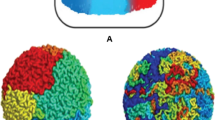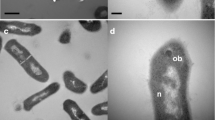Abstract
Changes in the topological state of DNA occur in a starvingEscherichia coli culture under oxidative stress caused by the addition of hydrogen peroxide. The addition of a carbon and energy source to this culture results in a second stress reaction. This supports previous data indicating that different mechanisms are responsible for the cell defense against oxidative stress in exponential and starvingE. coli cultures. Polyamine synthesis is involved in the cell adaptation to the stress. Putrescine binding to DNA and its dissociation seem to modulate the DNA topological state, which regulates the expression of the adaptive genes. An increase in the activity of the polyamine-synthesizing system in response to oxidative stress leads to a putrescine flux across the cytoplasmic membrane, due to which the antioxidant activity of putrescine protects the membrane phospholipids and contributes to the restoration of the cell energy-generating function
Similar content being viewed by others
References
Demple, B., Redox Signaling and Gene Control in theEscherichia coli soxRS Oxidative Stress Regulon: A Review,Gene, 1996, vol. 179, pp. 53–57.
Gonzalez Flecha, B. and Demple, B., Transcriptional Regulation of theEscherichia coli oxyR Gene as a Function of Cell Growth,J. Bacteriol., 1997, vol. 179, pp. 6181–6186.
Eisenstark, A., Calcutt, M.S., Becker Hapak, M., and Ivanova, A., Role ofEscherichia coli rpoS and Associated Genes in Defence Against Oxidative Damage,Free Radical Biol. Med., 1996, vol. 21, no. 7, pp. 975–983.
Wang, J.Y. and Syvanen, M., DNA Twist as a Transcriptional Sensor for Environmental Changes,Mol. Microbiol., 1992, vol. 6, no. 14, pp. 1861–1866.
Mencel, R. and Geliert, M., Regulation of Genes forEscherichia coli DNA Girase: Homeostatic Control of DNA Supercoiling,Cell, 1983, vol. 34, pp. 105–113.
van Workum, M., van Dooren, S.J., Oldenburg, N., Molenaar, D., Jensen, P.R., Snoep, J.L., and Westerhoff, H.V., DNA Supercoiling Depends on the Phosphorylation Potential inEscherichia coli, Mol. Micmbiol, 1996, vol. 20, no. 2, pp. 351–360.
Tkachenko, A.G., Salakhetdinova, O.Ya., and Pshenichnov, M.R., Putrescine/Potassium Exchange as an Adaptive Responseof Escherichia coli to Hyperosmotic Stress,Mikrobiologiya, 1997, vol. 66, no. 3, pp. 329–334.
Tkachenko, A.G. and Chudinov, A.A., Exchange of Polyamines between the Cell and the Medium as One of the Factors Determining the Development of Fed-Batch Cultures ofEscherichia coli, Mikwbiologiya, 1989, vol. 58, no. 4, pp. 584–590.
Atkinson, D.E., Adenylate Energy Charge Is a Key Factor,Trends Biochem. Sci., 1977, vol. 2, pp. 198–200.
Itnlay, J.A. and Linn, S., DNA Damage and Oxygen Radical Toxicity,Science, 1988, vol. 240, pp. 1302–1309.
Tkachenko, A.G., Pshenichnov, M.R., Salakhetdinova, O.Ya., and Nesterova, L.Yu., The Role of Putrescine and the Energy State ofEscherichia coli in the Regulation of DNA Topology during the Adaptation to Oxidative Stress,Mikwbiologiya, 1999, vol. 68, no. 1, pp. 27–32.
Ha, H.C., Sirisoma, N.S., Kuppusamy, P., Zweier, J.L., Woster, P.M., and Casero, R.A., The Natural Polyamine Spermine Functions Directly as a Free Radical Scavenger,Proc. Natl. Acad. Sci. USA, 1998, vol. 95, pp. 11140–11145.
Kashiwagi, K., Kobayashi, H., and Igarashi, K., Apparently Unidirectional Polyamine Transport by the Proton Motive Force in Polyamine-DeficientEscherichia coli, J. Bacteriol., 1986, vol. 165, pp. 972–977.
Urios, A., Herrera, G., Aleixandre, V., and Blanco, M., Expression ofrecA Gene Is Reduced inEscherichia coli Topoisomerase I Mutants,Mutation Res., 1990, vol. 243, pp. 267–272.
Tadolini, B., Polyamine Inhibition of Lipoperoxidation,Biochem. J., 1988, vol. 249, pp. 33–36.
Balke, V.L. and Gralla, G.D., Changes in the Linking Number of Supercoiled DNA Accompany Growth Transitions inEscherichia coli, J. Bacteriol., 1987, vol. 169, pp. 4499–4506.
Tkachenko, A.G. and Chudinov, A.A., Participation of Putrescine in the Antiport Mechanism of Potassium Transport inEscherichia coli, Curr. Microbiol., 1994, vol. 28, pp. 81–83.
Author information
Authors and Affiliations
Rights and permissions
About this article
Cite this article
Salakhetdinova, O.Y., Pshenichnov, M.R., Nesterova, L.Y. et al. Changes in the topological state of DNA duringEscherichia coli adaptation to oxidative stress under glucose starvation and after the transition to growth. Microbiology 69, 58–62 (2000). https://doi.org/10.1007/BF02757258
Received:
Issue Date:
DOI: https://doi.org/10.1007/BF02757258




